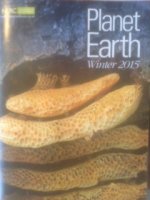Honeybees at an oceanography centre

By Alan Russell
- 872 reads
Yesterday, 21st May 2016, we made a visit to the National Oceanography Centre (NOC) in Southampton where there was an open day for members of the public to see what the institute does but more of that another day.
While we were walking through the exhibits I picked up a copy ‘Planet Earth – Winter 2015’ published by the Natural Environment Research Council (NERC). I was attracted to the magazine because as we were in the NOC I first thought the cover was a picture of some deep sea creature that had only just been discovered by the NOC. However, reality and the right glasses showed the cover picture is of circular honeycombs nestling in a log somewhere in France.
This very same picture was the header for an article in the magazine based on research about man’s relationship with bees, honey and beeswax.
The article went on to explain that Neolithic as far back as 8500 years ago were harvesting from bees’ nests. This conclusion was reached following the analysis of more than 6000 pottery fragments gathered from 150 Neolithic sights from England, France and as far away as southern Turkey. The pottery fragments showed they were carrying traces of honey and of those analysed some 83 had traces of beeswax which leaves its own unique chemical signature.
The honey would have been used as a sweetener much as we do today. The harvested beeswax ‘could have been used for various technological, ritual, cosmetic and medicinal purposes – for example, to waterproof ceramic vessels’.
No one knows yet if the bees were domesticated or wild but this research shows another insight into the incomplete mosaic of how people lived all those thousands of years ago.
- Log in to post comments


